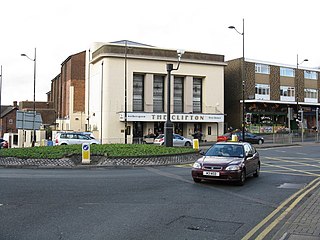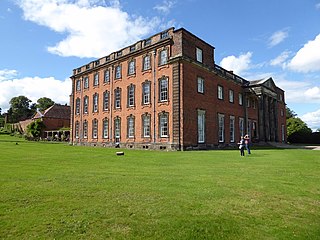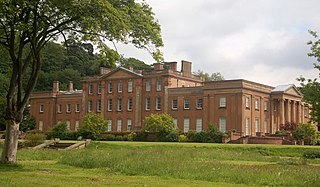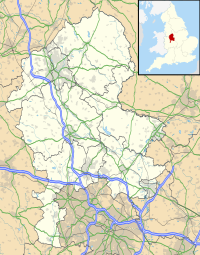
Dudley is a market town in the West Midlands, England, 6 miles (9.7 km) southeast of Wolverhampton and 8 miles (13 km) northwest of Birmingham. Historically part of Worcestershire, the town is the administrative centre of the Metropolitan Borough of Dudley. In the 2011 census, it had a population of 79,379. The Metropolitan Borough, which includes the towns of Stourbridge and Halesowen, had a population of 312,900. In 2014, the borough council named Dudley as the capital of the Black Country.

The Metropolitan Borough of Dudley is a metropolitan borough of West Midlands, England. It was created in 1974 following the Local Government Act 1972, through a merger of the existing Dudley County Borough with the municipal boroughs of Stourbridge and Halesowen.

Earl of Dudley, of Dudley Castle in the County of Stafford, is a title that has been created twice in the Peerage of the United Kingdom, both times for members of the Ward family.

Sedgley is a town in the north of the Metropolitan Borough of Dudley, in the West Midlands, England.

Darlaston is an industrial town in the Metropolitan Borough of Walsall in the West Midlands of England. It is located near Wednesbury and Willenhall.

Kingswinford is a town of the Metropolitan Borough of Dudley in the English West Midlands, situated 5 miles (8.0 km) west-southwest of central Dudley. In 2011 the area had a population of 25,191, down from 25,808 at the 2001 Census.

Staffordshire is a landlocked county in the West Midlands of England. It adjoins Cheshire to the north west, Derbyshire and Leicestershire to the east, Warwickshire to the south east, West Midlands and Worcestershire to the south, and Shropshire to the west. The historic county of Staffordshire includes Wolverhampton, Walsall, and West Bromwich, these three being removed for administrative purposes in 1974 to the new West Midlands authority. The resulting administrative area of Staffordshire has a narrow southwards protrusion that runs west of West Midlands to the border of Worcestershire. The city of Stoke-on-Trent was removed from the admin area in the 1990s to form a unitary authority, but is still part of Staffordshire for ceremonial and traditional purposes.

Witley Court, in Great Witley, Worcestershire, England, is a ruined Italianate mansion. Built for the Foleys in the seventeenth century on the site of a former manor house, it was enormously expanded in the early nineteenth century by the architect John Nash for Thomas Foley, 3rd Baron Foley. The estate was later sold to the Earls of Dudley, who undertook a second massive reconstruction in the mid-19th century, employing the architect Samuel Daukes to create one of the great palaces of Victorian and Edwardian England.

Chillington Hall is a Georgian country house near Brewood, Staffordshire, England, four miles northwest of Wolverhampton. It is the residence of the Giffard family. The Grade I listed house was designed by Francis Smith in 1724 and John Soane in 1785. The park and lake were landscaped by Capability Brown.

Weston Park is a country house in Weston-under-Lizard, Staffordshire, England, set in more than 1,000 acres (400 ha) of park landscaped by Capability Brown. The park is located 10 miles (16 km) north-west of Wolverhampton, and 8 miles (13 km) north-east of Telford, close to the border with Shropshire. The 17th-century Hall is a Grade I listed building and several other features of the estate, such as the Orangery and the Stable block, are separately listed as Grade II.

Wombourne is a village and civil parish located in the district of South Staffordshire, in the county of Staffordshire, England. It is 4 miles (6 km) south-west of Wolverhampton and just outside the county and conurbation of the West Midlands.

Gospel End is a village in the South Staffordshire district of Staffordshire, England. Population details taken at the 2011 census can be found under Himley. It is situated on the A463 road, between Sedgley and Wombourne.
Baggeridge Colliery was a colliery located in Sedgley, West Midlands England.
Swindon is a village and civil parish located in the West Midlands. The nearest major town is Dudley, approximately five miles eastwards. It stands halfway between the small town of Kingswinford and village of Wombourne.

Himley is a small village and civil parish in Staffordshire, England, 4 miles (6.4 km) west of Dudley and 5 mi (8.0 km) southwest of Wolverhampton. At the 2011 Census, it had a population of 802. Himley Hall was the home of the Lords of Dudley.
William Humble David Ward, 4th Earl of Dudley, styled Viscount Ednam from 1932 to 1969, was a British peer, a member of the House of Lords from 1969 to 1999.

Keele Hall is a 19th-century mansion house at Keele, Staffordshire, England, now standing on the campus of Keele University and serving as the university conference centre. It is a Grade II* listed building.

Baggeridge Country Park is located within the South Staffordshire district of Staffordshire, England. Its entrance is on the A463 just west of Gospel End, a small Staffordshire village just beyond the borders of the Wolverhampton, Gornal and the surrounding Metropolitan Borough of Dudley.
Himley is a civil parish in the district of South Staffordshire, Staffordshire, England. It contains twelve listed buildings that are recorded in the National Heritage List for England. Of these, one is at Grade II*, the middle of the three grades, and the others are at Grade II, the lowest grade. The most important building in the parish is Himley Hall, a country house, which is listed together with associated structures and items in the grounds, Himley Park. The other listed buildings include a former rectory and associated structures, houses, a church, a hotel, a public house, and an ice house.


















